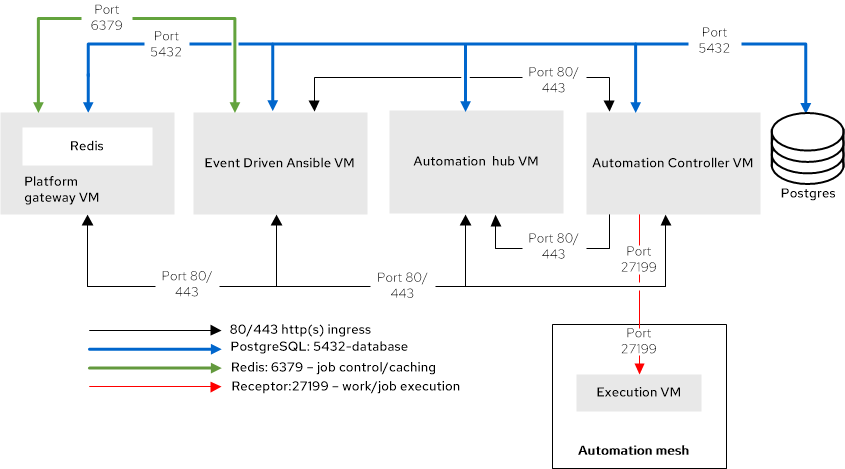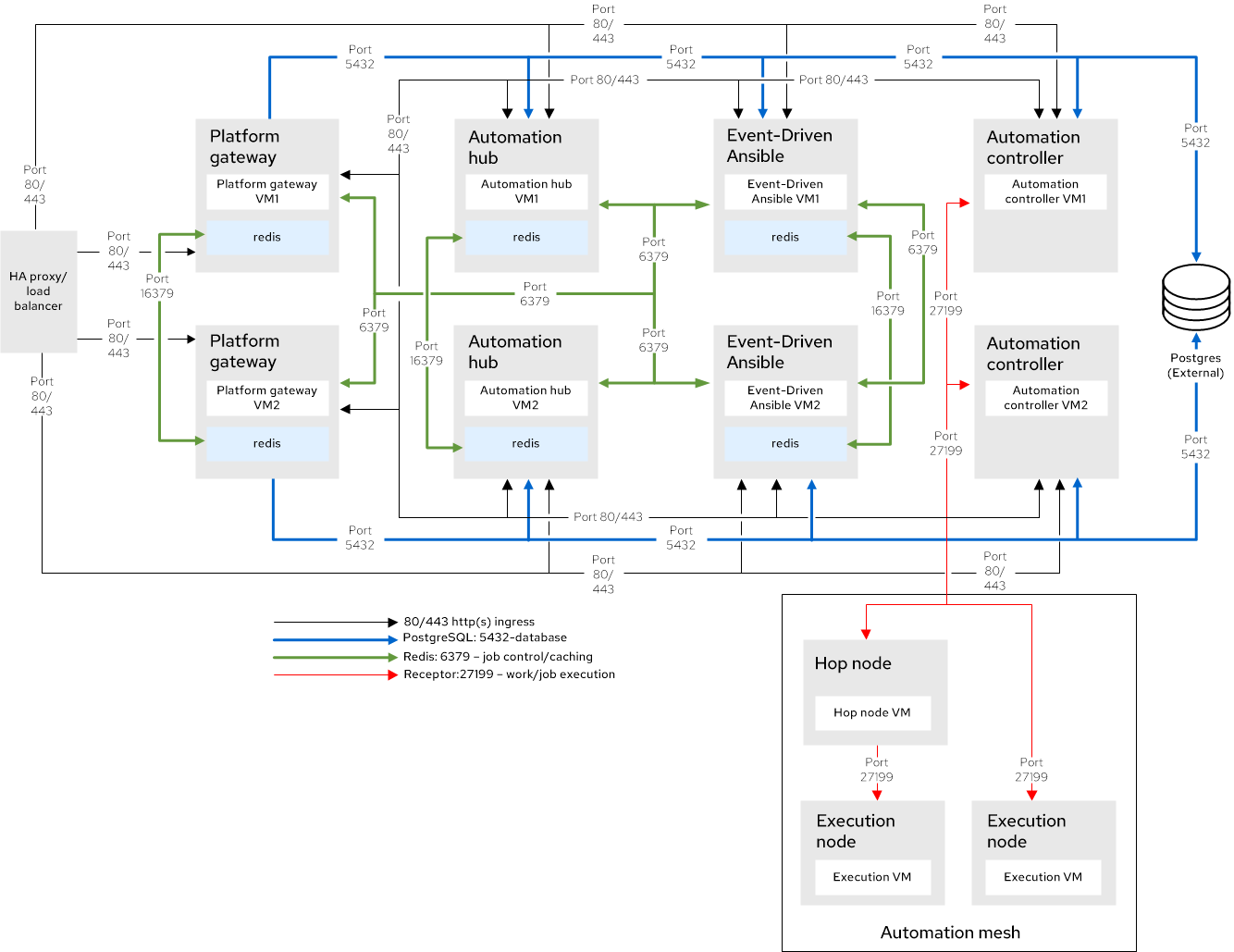Questo contenuto non è disponibile nella lingua selezionata.
Chapter 2. RPM topologies
The RPM installer deploys Ansible Automation Platform on Red Hat Enterprise Linux by using RPMs to install the platform on host machines. Customers manage the product and infrastructure lifecycle.
2.1. RPM growth topology
The growth topology is intended for organizations that are getting started with Ansible Automation Platform and do not require redundancy or higher compute for large volumes of automation. This topology allows for smaller footprint deployments.
2.1.1. Infrastructure topology
The following diagram outlines the infrastructure topology that Red Hat has tested with this deployment model that customers can use when self-managing Ansible Automation Platform:
Figure 2.1. Infrastructure topology diagram
Each VM has been tested with the following component requirements:
| Requirement | Minimum requirement |
|---|---|
| RAM | 16 GB |
| CPUs | 4 |
| Local disk | 60 GB |
| Disk IOPS | 3000 |
| VM count | Purpose | Example VM group names |
|---|---|---|
| 1 | Platform gateway with colocated Redis |
|
| 1 | Automation controller |
|
| 1 | Private automation hub |
|
| 1 | Event-Driven Ansible |
|
| 1 | Automation mesh execution node |
|
| 1 | Ansible Automation Platform managed database |
|
2.1.2. Tested system configurations
Red Hat has tested the following configurations to install and run Red Hat Ansible Automation Platform:
| Type | Description | |
|---|---|---|
| Subscription | Valid Red Hat Ansible Automation Platform subscription | |
| Operating system |
| |
| CPU architecture | x86_64, AArch64, s390x (IBM Z), ppc64le (IBM Power) | |
|
|
| Ansible Automation Platform uses the system-wide ansible-core package to install the platform, but uses ansible-core 2.16 for both its control plane and built-in execution environments. |
| Browser | A currently supported version of Mozilla Firefox or Google Chrome | |
| Database | PostgreSQL 15 | External (customer supported) databases require ICU support. |
2.1.3. Network ports
Red Hat Ansible Automation Platform uses several ports to communicate with its services. These ports must be open and available for incoming connections to the Red Hat Ansible Automation Platform server for it to work. Ensure that these ports are available and are not blocked by the server firewall.
| Port number | Protocol | Service | Source | Destination |
|---|---|---|---|---|
| 80/443 | TCP | HTTP/HTTPS | Event-Driven Ansible | Automation hub |
| 80/443 | TCP | HTTP/HTTPS | Event-Driven Ansible | Automation controller |
| 80/443 | TCP | HTTP/HTTPS | Automation controller | Automation hub |
| 80/443 | TCP | HTTP/HTTPS | Platform gateway | Automation controller |
| 80/443 | TCP | HTTP/HTTPS | Platform gateway | Automation hub |
| 80/443 | TCP | HTTP/HTTPS | Platform gateway | Event-Driven Ansible |
| 5432 | TCP | PostgreSQL | Event-Driven Ansible | Database |
| 5432 | TCP | PostgreSQL | Platform gateway | Database |
| 5432 | TCP | PostgreSQL | Automation hub | Database |
| 5432 | TCP | PostgreSQL | Automation controller | Database |
| 6379 | TCP | Redis | Event-Driven Ansible | Redis node |
| 6379 | TCP | Redis | Platform gateway | Redis node |
| 8443 | TCP | HTTPS | Platform gateway | Platform gateway |
| 27199 | TCP | Receptor | Automation controller | Execution node |
2.1.4. Example inventory file
Use the example inventory file to perform an installation for this topology:
2.2. RPM enterprise topology
The enterprise topology is intended for organizations that require Ansible Automation Platform to be deployed with redundancy or higher compute for large volumes of automation.
2.2.1. Infrastructure topology
The following diagram outlines the infrastructure topology that Red Hat has tested with this deployment model that customers can use when self-managing Ansible Automation Platform:
Figure 2.2. Infrastructure topology diagram
Each VM has been tested with the following component requirements:
| Requirement | Minimum requirement |
|---|---|
| RAM | 16 GB |
| CPUs | 4 |
| Local disk | 60 GB |
| Disk IOPS | 3000 |
| VM count | Purpose | Example VM group names |
|---|---|---|
| 2 | Platform gateway with colocated Redis |
|
| 2 | Automation controller |
|
| 2 | Private automation hub with colocated Redis |
|
| 2 | Event-Driven Ansible with colocated Redis |
|
| 1 | Automation mesh hop node |
|
| 2 | Automation mesh execution node |
|
| 1 | Externally managed database service | N/A |
| 1 | HAProxy load balancer in front of platform gateway (externally managed) | N/A |
- 6 VMs are required for a Redis high availability (HA) compatible deployment. Redis can be colocated on each Ansible Automation Platform component VM except for automation controller, execution nodes, or the PostgreSQL database.
- External Redis is not supported for RPM-based deployments of Ansible Automation Platform.
2.2.2. Tested system configurations
Red Hat has tested the following configurations to install and run Red Hat Ansible Automation Platform:
| Type | Description | |
|---|---|---|
| Subscription | Valid Red Hat Ansible Automation Platform subscription | |
| Operating system |
| |
| CPU architecture | x86_64, AArch64, s390x (IBM Z), ppc64le (IBM Power) | |
|
|
| Ansible Automation Platform uses the system-wide ansible-core package to install the platform, but uses ansible-core 2.16 for both its control plane and built-in execution environments. |
| Browser | A currently supported version of Mozilla Firefox or Google Chrome | |
| Database | PostgreSQL 15 | External (customer supported) databases require ICU support. |
2.2.3. Network ports
Red Hat Ansible Automation Platform uses several ports to communicate with its services. These ports must be open and available for incoming connections to the Red Hat Ansible Automation Platform server for it to work. Ensure that these ports are available and are not blocked by the server firewall.
| Port number | Protocol | Service | Source | Destination |
|---|---|---|---|---|
| 80/443 | TCP | HTTP/HTTPS | Event-Driven Ansible | Automation hub |
| 80/443 | TCP | HTTP/HTTPS | Event-Driven Ansible | Automation controller |
| 80/443 | TCP | HTTP/HTTPS | Automation controller | Automation hub |
| 80/443 | TCP | HTTP/HTTPS | HAProxy load balancer | Platform gateway |
| 80/443 | TCP | HTTP/HTTPS | Platform gateway | Automation controller |
| 80/443 | TCP | HTTP/HTTPS | Platform gateway | Automation hub |
| 80/443 | TCP | HTTP/HTTPS | Platform gateway | Event-Driven Ansible |
| 5432 | TCP | PostgreSQL | Event-Driven Ansible | External database |
| 5432 | TCP | PostgreSQL | Platform gateway | External database |
| 5432 | TCP | PostgreSQL | Automation hub | External database |
| 5432 | TCP | PostgreSQL | Automation controller | External database |
| 6379 | TCP | Redis | Event-Driven Ansible | Redis node |
| 6379 | TCP | Redis | Platform gateway | Redis node |
| 8443 | TCP | HTTPS | Platform gateway | Platform gateway |
| 16379 | TCP | Redis | Redis node | Redis node |
| 27199 | TCP | Receptor | Automation controller | Hop node and execution node |
| 27199 | TCP | Receptor | Hop node | Execution node |
2.2.4. Example inventory file
Use the example inventory file to perform an installation for this topology:

